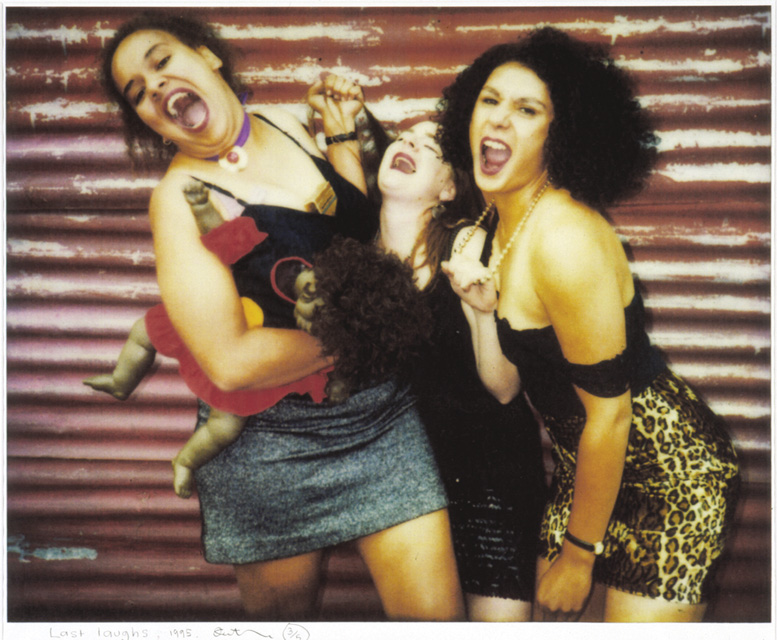


A brilliant performer, academic and activist, Destiny Deacon's several careers reflect the complexity of her role as artist. Her work is a direct expression of her life; she is, as she once put it, 'just an old-fashioned political artist'1 In installations, videos and laser-generated prints, Deacon considers the casual cruelty and indirect violence of everyday racism through a humour particular to her identity – an 'urban Australian Aboriginal survivor ... of the colonial wars'.2
Deacon's nation is Kuku from far north Queensland and Erub, Mer in the Torres Strait Islands. She was born in Maryborough, Queensland and after an itinerant early childhood—her father was a wharfie always on the lookout for work—she grew up in inner-city Melbourne. Her 1998 work Postcards from mummy documents the artist's trip retracing her mother's journey 'from Cooktown to Brisbane'3 after she left Darnley Island and before she met Deacon's father. For the artist, who is 'bloody terrified of the bush',4 it is a landscape both foreign and ominous, beautiful and removed, captured in snapshots largely taken from a car window—souvenirs for a tourist in her own country.
Like the entertainer Tiny Tim, Deacon has a habit of addressing people formally (as 'Miss Natalie' or 'Miss Hannah') as though they were schoolteachers or even royalty—dreaded figures of authority—or maybe just presenters on Hello Humphrey. Deacon at once revels and collapses in self-abjection, pretending to cower in order to conquer. As Hetti Perkins has noted, you never know quite where she is coming from—and that's how she 'gets' her viewer, with side-swipes and back-handers.
Abjection is a form of self-protection, and Deacon's work revolves around the many contradictions with which contemporary Indigenous life is riven. 'Nothing surprises most of us Indigenous women any more,' she has said of the 1999 work, It shows no fear. 'It's got that way if a flying-saucer was in our midst, we wouldn't give it a second look.'5 The ludicrous is a useful organising principle for artists dealing with a history and present so outrageous as to be unbelievable, and Deacons' images are object lessons in how to live with outrage.
Last laughs is one of Deacon's best works. At first glance it is also one of her least disturbing—girlfriends dressed up for a bit of fun. But what exactly is going on here? Are these smiles or grimaces, predatory snarls or masks of pain? As one exhibition was titled, these girls are 'smiling dangerously'. Jokes mostly rely on mocking the weak—in humour, cruelty is given free reign. Yet in Deacon's twisted currency, one cannot be quite sure who is telling the joke and who the joke is on. As Marcia Langton has written:
Destiny loves to resurrect the imagery of our oppression, position her favourite dolls or people in her stage sets, and eke out the discomfort. I have often wondered if her work irritates whites in the same way as it irritates me. Or is the message different for them?6
Deacon lampoons victimhood in works which are nevertheless full of pathos. Pity and affection vie with revulsion: Deacon says she uses dolls in her works because she feels sorry for them. The implication is that kitsch representations of Aboriginal people have come to stand-in for Aboriginal people themselves; like voodoo dolls, these battered junk-shop dollies are mascots of the grotesque incongruity between real and imagined indigeneity. There is nothing vicarious about Indigenous suffering, however, and beneath the jest is the living hurt of a history of poverty and contempt.
Deacon's anti-art is seemingly slapdash but is in fact thoroughly cunning. She describes herself as 'just a crappy artist', and the 'worse' the art—the more unfocussed or uneventful—the tougher its impact. Deacon's desultory art gives the finger to the narcissism of artmaking; indeed, one even gets the impression that she is only reluctantly an artist. As one series was titled, she has been 'forced into images'. Yet although apparently incidental, Deacon's images are far from casually acquired; in between the inaudible dialogue and unedited meanderings, the home video Talking pictures shows a perfectionist at work. Deacon's beautiful portraits—of herself as Frida Kahlo, or of the artists Janet Burchill and Jennifer McCamley—demonstrate the extent to which the artist works against her innate aestheticism.
- Hannah Fink
Destiny Deacon is represented in Australia by Roslyn Oxley9 Gallery, Sydney.